Click on images to enlarge
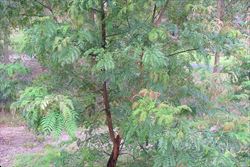
habit (Photo: Sheldon Navie)

habit of mature tree (Photo: Sheldon Navie)

very rough, dark brown bark on the main trunk (Photo: Sheldon Navie)
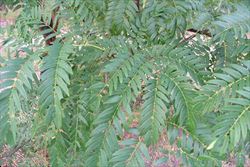
large twice-compound leaves (Photo: Sheldon Navie)
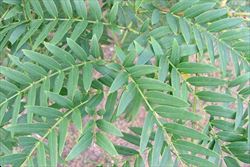
leaf showing several leaf branchlets, each with numerous pairs of relatively large leaflets (Photo: Sheldon Navie)
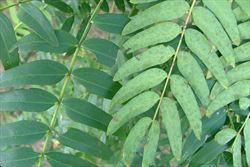
upper and lower surfaces of leaflets (Photo: Sheldon Navie)

close-up showing the small raised gland at the junction of the uppermost pair of leaf branchlets (Photo: Sheldon Navie)
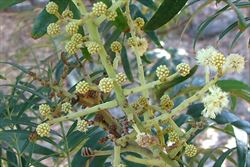
clusters of pale yellow or cream flowers (Photo: Sheldon Navie)
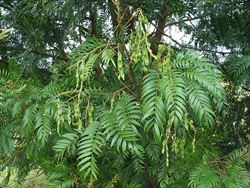
immature fruit (Photo: Jackie Miles and Max Campbell)
Scientific Name
Acacia elata A. Cunn. ex Benth.
Synonyms
Acacia elata GrahamAcacia terminalis (Salisb.) J.F. Macbr. (misapplied)Racosperma elatum (A. Cunn. ex Benth.) Pedley
Family
Fabaceae: sub-family Mimosoideae (New South Wales)Leguminosae (South Australia)Mimosaceae (Queensland, the ACT, Victoria, Tasmania, Western Australia and the Northern Territory)
Common Names
cedar wattle, mountain cedar wattle, new year wattle, pepper-tree wattle, peppertree wattle
Origin
Mountain cedar wattle (Acacia elata) is native to the coastal and tableland districts of central and northern New South Wales, from the Budawang Range north to the Bellinger River. It is most common in the Blue Mountains and in the Moss Vale-Mittagong district.
Cultivation
This fast-growing species is cultivated in parks and gardens, and as a windbreak, in many parts of Australia (particularly in southern regions).
Naturalised Distribution
Naturalised in southern Victoria (particularly east of Melbourne) and in the coastal districts of south-western Western Australia. It is possibly naturalised beyond its native range in New South Wales, and there are also unconfirmed reports of it being naturalised in the ACT.
Mountain cedar wattle (Acacia elata) and has also become naturalised in southern Africa, New Zealand, and in California in south-western USA.
Habitat
Mountain cedar wattle (Acacia elata) grows naturally in rainforests, wet sclerophyll forests and tall open forests, mainly on the ranges of eastern New South Wales. In these areas it often grows in deep sandy soils, particularly along watercourses and in deep gullies.
In Western Australia, where it has become naturalised, it grows along waterways and in jarrah woodlands. While in South Africa it grows in forest clearings, in fynbos shrublands, along roadsides, in moist sites, and in open spaces in urban areas.
Habit
An upright (i.e. erect) and spreading tree usually growing 7-20 m tall, but occasionally reaching up to 30 m in height.
Distinguishing Features
- a tree with twice-compound leaves that have dark green upper surfaces and pale green undersides.
- its leaf stalks have a prominent raised gland halfway between their base and the lowest pair of leaf branchlets.
- glands are also present at the junction of the upper 1-5 pairs of leaflets on the leaf branchlets.
- its pale yellow or cream flowers are borne in small globular clusters that are arranged into larger elongated compound clusters.
- its fruit is a large, elongated and flattened pod (40-175 mm long).
Seedling
Seedlings have two undivided seed leaves (i.e. cotyledons). The first true leaves are usually compound (i.e. pinnate or bipinnate), but only with one or a few pairs of branchlets (i.e. pinnae).
Stems and Leaves
The bark is rough at base of the trunk and grey to blackish in colour. Mature trees may have trunks that are up to 60 cm across. The younger branches are rounded or slightly flattened (sometimes also slightly ridged) and often have a sparse covering of tiny golden-coloured hairs. Older branches have a similar covering of tiny whitish or greyish coloured hairs. The young foliage-tips are golden yellow, pinkish-red or cream-coloured and covered with silky and sticky (i.e. glandular) yellowish or whitish hairs.
The leaves are twice-compound (i.e. bipinnate) with dark green upper surfaces and much paler green undersides. These leaves are relatively large (30-40 cm long) are alternately arranged along the stems. They are stalked (i.e. petiolate) and the extension of the leaf stalk (i.e. rachis) bears a few to several (2-7) pairs of branchlets (i.e. pinnae). The leaf stalk (i.e. petiole) is hairless or slightly hairy (25-90 mm long), rounded in cross-section (i.e. terete), and has a swollen base (i.e. pulvinus). There is a prominent, dark brown raised structure (i.e. gland) about halfway between the base of the leaf stalk and the lowest pair of leaf branchlets (i.e. pinnae). The extension of the leaf stalk (3-22 cm long) is slightly hairy or hairless (i.e. puberulent or glabrous), and sometimes has a small raised structure (i.e. gland) at the junction of the uppermost pair of leaf branchlets (i.e. pinnae). The leaf branchlets (7-25 cm long) each bear several to numerous (8-22) pairs of leaflets (i.e. pinnules). There are small raised structures on the leaf branchlets (i.e. pinnae) at the junction of the upper 1-5 or more pairs of leaflets (i.e. pinnules). The relatively large leaflets (10-60 mm long and 3-13 mm wide) are elongated in shape (i.e. lanceolate to narrowly lanceolate), and often slightly curved. Their upper surfaces are mostly hairless (sometimes with a few sparse appressed hairs), while their lower surfaces have a moderately dense covering of whitish or yellowish coloured hairs. They have entire margins and strongly pointed tips (i.e. acuminate apices).
Flowers and Fruit
The small pale yellow or cream-coloured flowers are very fluffy in appearance and are densely arranged into small globular clusters (7-10 mm across). These flowers have five relatively inconspicuous petals and sepals and numerous conspicuous stamens. The globular flower clusters each contain numerous (30-55) flowers and are are borne on short stalks (i.e. peduncles) 2-16 mm long that are usually covered in yellowish hairs. They are arranged along a small branch emanating from the forks (i.e. axils) of the leaves, or are occasionally borne at the tips of the stems. These branches may or may not be further branched (i.e. they form inflorescences resembling racemes or panicles). Flowering generally occurs during summer and early autumn (i.e. from December to March), but may also extend through to late autumn (i.e. until May).
The fruit is an elongated and flattened pod (40-175 mm long and 9-15 mm wide) with prominent margins. These pods are sometimes slightly constricted between some or all of the seeds. Younger pods are green in colour and densely covered in tiny yellow hairs (i.e. pubescent). They turn dark brown or grey in colour and become hairless or sparsely hairy (i.e. glabrous or puberulent) as they mature. Each pod contains several seeds (about 6 mm long) which have a relatively large fleshy structure (i.e. aril) attached to them.
Reproduction and Dispersal
Reproduction in this species is entirely by seed. These seeds may be dispersed by ants, birds, wind and water. They may also be spread in dumped garden waste and contaminated soil.
Environmental Impact
Mountain cedar wattle (Acacia elata) is regarded as a significant environmental weed in Victoria and as an environmental weed in Western Australia and some parts of New South Wales. It is widely cultivated, particularly in southern Australia, and has the potential to escape into adjacent bushland under suitable conditions.
Mountain cedar wattle (Acacia elata) is known to invade relatively undisturbed forests in Victoria, and is particularly invasive in higher rainfall areas. It poses a potential threat to one or more vegetation formations in this state and appears on numerous local environmental weed lists in southern Victoria. In south-western Western Australia, mountain cedar wattle (Acacia elata) is spreading along creeklines in the Darling Range and invading jarrah woodlands. Even though this species is native to many parts of central New South Wales, it is considered by some to spreading beyond its native range in the Sydney region.
In South Africa, mountain cedar wattle (Acacia elata) invades various habitats including forest clearings, fynbos shrublands, roadsides, moist sites, and open spaces in urban areas.
Legislation
Mountain cedar wattle (Acacia elata) is not declared or considered noxious by any state or territory government in Australia.
Management
For information on the management of this species see the following resources:
- the Weeds in your Bush section of the Tasmanian Bushcare Toolkit which is available online at http://www.dpiw.tas.gov.au.
Similar Species
Mountain cedar wattle (Acacia elata) is quite distinctive among the wattles, because of its very large twice-compound leaves. However, it has been confused with sunshine wattle (Acacia terminalis) in the past, which has very similar flowers and fruit. These species can be distinguished by the following differences:
- mountain cedar wattle (Acacia elata) is a relatively large tree usually growing 7-20 m tall. Its relatively large leaves (20-40 cm long) have dark green upper surfaces and paler undersides, with a few or several (2-7) pairs of branchlets (i.e. pinnae). Their leaflets are also quite large (10-60 mm long and 3-13 mm wide) and there are small raised structures (i.e. glands) on the leaf branchlets (i.e. pinnae), at the junction of the upper 1-5 pairs of leaflets (i.e. pinnules).
- sunshine wattle (Acacia terminalis) is a shrub or small tree usually less than 6 m tall. Its relatively small (1-14 cm long) leaves have dark green upper surfaces and paler undersides, with a few or several (1-8) pairs of branchlets (i.e. pinnae). Their leaflets are also relatively small (2-18 mm long and 1-6 mm wide) and there are no small raised structures (i.e. glands) on the leaf branchlets (i.e. pinnae).
The leaves of mountain cedar wattle (Acacia elata) are also similar in appearance to those of pepper tree (Schinus areira) at first glance. However, the leaves of pepper tree (Schinus areira) are only once-divided (i.e. pinnate), and the tiny whitish-coloured flowers and small pink fruit of this species are totally different.
Note: This page only covers those species that have been reported to be commonly confused with mountain cedar wattle (Acacia elata). For a more in-depth key to all of the wattle (Acacia spp.) present in Australia, see the Wattle: Acacias of Australia CD-ROM or Flora of Australia, Volumes 11A and 11B.

